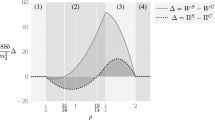Abstract
This paper is concerned with the existence, uniqueness and computation of leader-follower equilibrium solutions for an industry involved with two major stages of production. We assume that there exists one set of firms performing the first stage of production, which produces a semi-finished product. This semi-finished product is converted to a final good by a second set of firms performing the second stage of production. Furthermore, also competing in the final product market is a third set of firms, which are vertically integrated through the two stages of production and which are assumed to lead the second set of firms by explicitly considering the reaction or response of these latter firms to their own outputs. We model such an industry as a two-stage network of oligopolies, and define equilibrium solutions based on assumed market structures. Our analysis examines the existence and uniqueness of such equilibrium solutions, characterizes the nature of the production strategies of the various firms at an equilibrium, and prescribes algorithms to compute such solutions. This provides the machinery required to perform sensitivity analyses for studying the effects of various mergers or integrations on individual firm profits, and on the industry outputs and prices at equilibrium. The presentation is self-contained, and does not necessarily require any significant prior preparation in economic theory on the part of the reader.
Similar content being viewed by others
References
A.A. Cournot, Recherches sur les principes mathematiques de la théorie des richesses, in:Libraire de Sciences Politiques et Sociale (M. Rivière & Cie, Paris, 1838).
J.W. Friedman,Oligopoly and the Theory of Games (North-Holland, Amsterdam, 1977).
D. Furth, The stability of generalized Stackelberg equilibria in heterogeneous oligopoly, J. Econ. 39(1979)315–322.
M.L. Greenhut and H. Ohta, Related market conditions and interindustrial mergers, Amer. Econ. Rev. 66(1976)267–277.
M.L. Greenhut and H. Ohta, Vertical integration of successive oligopolies, Amer. Econ. Rev. 69(1979)137–141.
J.R. Haring and D.L. Kaserman, Related market conditions and interindustrial mergers: Comment, Amer. Econ. Rev. 68(1978)225–227.
J.M. Leleno, A mathematical programming-based analysis of a two-stage model of interacting producers, Ph.D. Dissertation, Department of Industrial Engineering and Operations Research, Virginia Polytechnic Institute and State University, Blacksburg, VA 24061 (1987), unpublished.
F.H. Murphy, H.D. Sherali and A.L. Soyster, A mathematical programming approach for determining oligopolistic market equilibrium, Math. Progr. 24(1982)92–106.
J. Nash, Non-cooperative games, Ann. Math. 54(1951)286–295.
W. Novshek, Finding alln-firm Cournot equilibria, Int. Econ. Rev. 25(1984)61–70.
K. Okuguchi,Expectations and Stability in Oligopoly Models, Lecture Notes in Economics and Mathematical Systems No 138 (Springer, New York, 1976).
K. Okuguchi, The stability of price adjusting oligopoly with conjectural variations, J. Econ. 38(1978)50–60.
M.K. Perry, Related market conditions and interindustrial mergers: Comment, Amer. Econ. Rev. 68(1978)221–224.
R.B. Rovinsky, C.A. Shoemaker and M.J. Todd, Determining optimal use of resources among regional producers using different levels of cooperation, Oper. Res. 28(1980)859–866.
H.D. Sherali, A multiple leader Stackelberg model and analysis, Oper. Res. 32(1984)390–404.
H.D. Sherali, A.L. Soyster and F.H. Murphy, Stackelberg-Nash-Cournot equilibria: Characterizations and computations, Oper. Res. 31(1983)253–276.
H.D. Sherali and J.M. Leleno, A mathematical programming approach to a Nash-Cournot equilibrium analysis for a two-stage network of oligopolies, Oper. Res. 36(1988)682–702.
H. Stackelberg,Marktform und Gleichgewicht (Julius Springer, Vienna, 1934).
F. Szidarovszky and S. Yakowitz, A new proof of the existence and uniqueness of the Cournot equilibrium, Int. Econ. Rev. 18(1977)787–789.
F. Szidarovszky and S. Yakowitz, Contributions to Cournot oligopoly theory, J. Econ. Theory 28(1982)51–70.
Author information
Authors and Affiliations
Additional information
This paper is based on work done for the Minerals and Mining Resources Research Institute, under the sponsorship of the Bureau of Mines, Department of the Interior.
Rights and permissions
About this article
Cite this article
Leleno, J.M., Sherali, H.D. A leader-follower model and analysis for a two-stage network of oligopolies. Ann Oper Res 34, 37–72 (1992). https://doi.org/10.1007/BF02098172
Issue Date:
DOI: https://doi.org/10.1007/BF02098172



